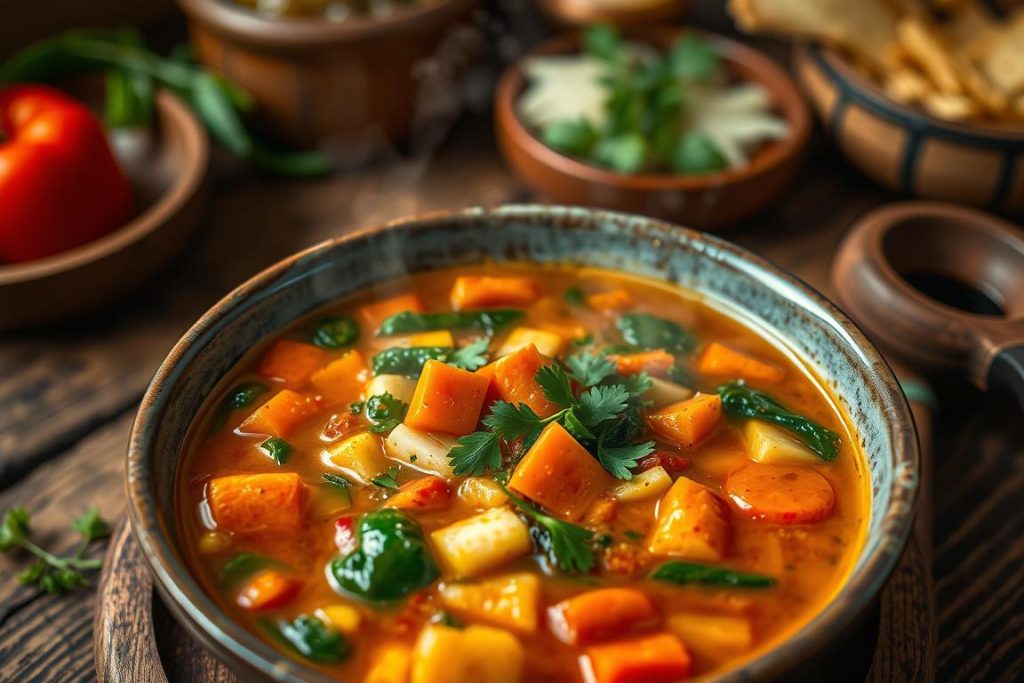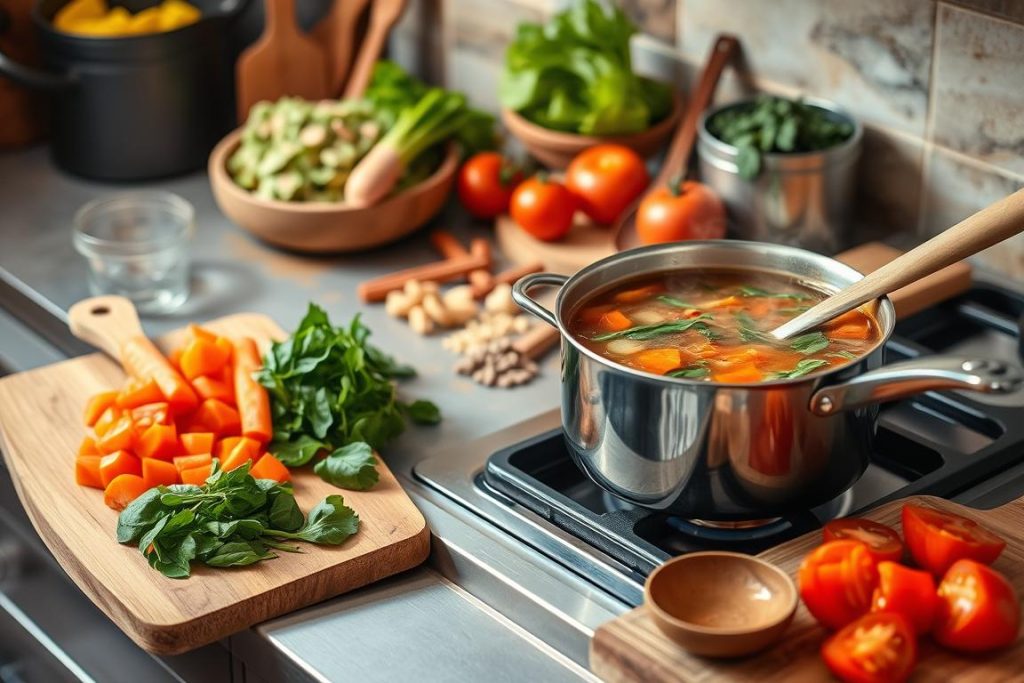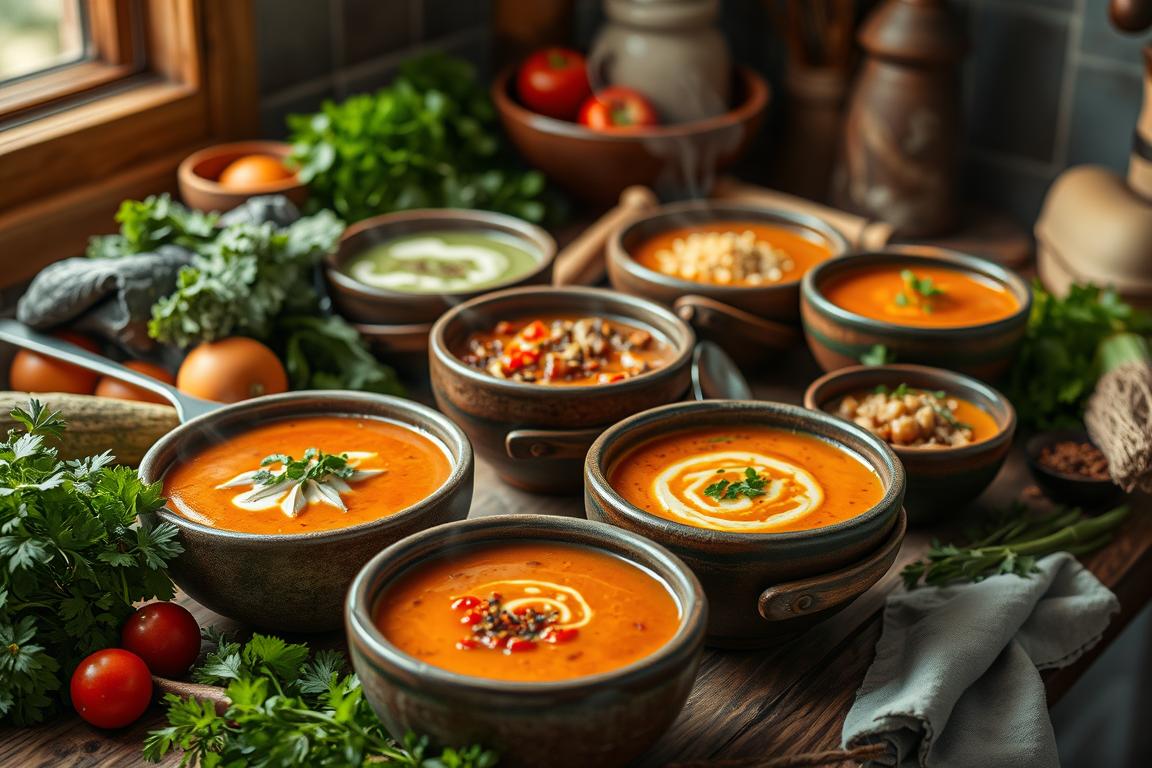Winter is here, and vegan soups are the perfect comfort. These bowls of goodness are full of veggies, proteins, and spices. They’re a great way to enjoy the season and feel good.
In this guide, we’ll show you how to make delicious vegan soups. You’ll learn about plant-based broths and vegetable stews. Whether you’re a vegan pro or new to plant-based meals, you’ll find great recipes and tips.
Why January Is Perfect for Vegan Soups
January is the perfect time to enjoy vegan soups. These soups, like dairy-free chowders and meatless bisques, are warm and comforting. They are also kind to animals and good for you during the cold winter months.
Post-Holiday Wellness Benefits
After the holiday season, vegan soups help your body recover. They are full of vitamins, proteins, and gentle broths. These foods help you feel refreshed and ready for the new year.
Seasonal Ingredient Availability
January is great for finding fresh winter produce. This produce, like root veggies and herbs, makes vegan soups taste amazing. It brings the best of winter right to your plate.
Budget-Friendly Meal Planning
- Vegan soups are a smart choice for saving money in the new year.
- They use affordable, seasonal ingredients and plant-based proteins. This makes them a budget-friendly option for meals.
- Also, making big batches of vegan soups helps with meal prep. It saves money and time.
Start the new year with vegan soups. They offer a great way to recover from the holidays, use fresh winter ingredients, and save money. January is the best time to try these delicious, animal-friendly soups.
Essential Kitchen Tools for Making Plant-Based Broths
Making tasty vegan soups starts with the right tools. Improve your vegan soup-making with these key appliances and utensils. From immersion blenders to pressure cookers, get your kitchen ready for flavorful plant-based broths.
- Immersion Blender: This handy tool lets you blend ingredients right in the pot. It makes your vegan soups silky-smooth.
- High-Speed Blender: For creamy nut-based broths and veggie purées, a strong blender is essential.
- Pressure Cooker: A pressure cooker brings out the best flavors in your vegan soup ingredients. It also cuts down cooking time.
- Slow Cooker: Use a slow cooker to let your vegan soup simmer perfectly. It’s great for letting flavors blend over time.
- Vegetable Scraps Bags: Save veggie scraps and peels in the freezer. They make a tasty homemade vegan broth base.
With the right tools, you’re set to make delicious, plant-based soups. Try out different appliances and methods to find your favorite way to make vegan soups.
Base Ingredients for Flavorful Vegan Soups
Making tasty vegan soups begins with key ingredients. These include aromatic veggies, plant-based proteins, and natural thickeners. Together, they add depth, texture, and nutrition to your plant-based dishes.
Aromatics and Herbs
The core of vegan soups is onions, garlic, celery, carrots, and herbs. Sautéing them in olive oil or broth starts the soup-making journey. This step fills your soup with a wonderful smell.
Herbs like thyme, rosemary, and bay leaves add to the flavor. Fresh parsley, cilantro, or basil bring a bright finish.
Plant-Based Protein Sources
For a filling and nutritious vegan soup, add protein-rich ingredients. Use legume purées, tofu, tempeh, or seitan. These add a creamy texture and plant-based protein.
Adding cubed or crumbled protein makes broth-based soups more hearty.
Natural Thickening Agents
For the right consistency, use whole grains, starchy veggies, and nut or seed butters. Cooked barley, quinoa, or brown rice can make the soup creamy. Mashed potatoes, sweet potatoes, or pureed cauliflower also thicken soups naturally.
Learning to use aromatic veggies, plant-based proteins, and natural thickeners will help you make delicious vegan soups. These soups will be satisfying and enjoyable.
Nutritional Benefits of Plant-Based Soups
Adding vegan meal ideas like plant-based soups to your diet is great for your health. These soups are tasty and packed with vitamins, minerals, and fiber. They help keep you healthy and feeling good.
Vegan soups are full of nutrients. Ingredients like leafy greens, root veggies, and legumes are loaded with antioxidants. These help boost your immune system, especially when it’s cold.
| Nutrient | Benefits | Vegan Soup Ingredients |
|---|---|---|
| Vitamin C | Supports immune function, promotes skin health | Bell peppers, tomatoes, broccoli, cauliflower |
| Vitamin A | Enhances vision, maintains healthy skin and mucus membranes | Carrots, sweet potatoes, pumpkin, spinach |
| Fiber | Aids digestion, promotes feelings of fullness | Lentils, chickpeas, barley, whole grains |
Plant-based soups are also very satisfying and comforting. They mix a soothing broth with tender veggies and protein like beans or tofu. This makes a dish that warms you up and makes you feel great.
If you’re vegan or just want healthier meals, try plant-based soups. They’re a tasty and nutritious way to take care of your body and feel your best.
Mastering Dairy-Free Chowders and Creamy Soups
Do you love creamy soups but can’t have dairy? Don’t worry, you can still enjoy them with plant-based ingredients. Learning to make dairy-free chowders and veloutés is simple. With the right ingredients and techniques, you can make creamy soups that are both healthy and delicious.
Nut-Based Cream Alternatives
Cashews, almonds, and coconut milk are great for making creamy soups without dairy. These ingredients can be blended into nut-based creams that feel like traditional dairy. Soak the nuts first for a smooth texture, then mix them with broth or water for a creamy base.
Vegetable Puree Techniques
Vegetables can also make your soups creamy without dairy. Blend starchy veggies like potatoes, cauliflower, or squash until they’re smooth. Then, add them to your soup for a tofu-infused veloutés texture. Don’t forget to season well to enhance the flavors of your plant-based ingredients.
Now you know the secrets to making amazing dairy-free chowders and creamy soups. Try using nut-based creams and vegetable purées. You’ll love the comforting and satisfying tastes of dairy-free soups.
Quick and Easy Vegan Soup Recipes
Winter brings a need for warmth, and nothing does that better than a bowl of vegan soup. Making tasty plant-based broths and soups is easy and fast. Here are some simple yet delicious vegan soup recipes for busy weeknights.
Try hearty lentil soups that are ready in under 30 minutes. Or, make a one-pot vegetable minestrone. These recipes show that vegan comfort food can be quick and healthy. They’re full of good ingredients and flavors, making everyone want more.
- 30-Minute Lentil Soup with Kale
- Creamy Cauliflower Bisque
- Instant Pot Butternut Squash Soup
- One-Pot Veggie Minestrone
- Sweet Potato and Coconut Curry Soup
Looking for a hearty bean chili or a light vegetable puree? These vegan soup recipes have you covered. They require little prep and are easy to cook, so you can enjoy homemade plant-based soups any night.

So, grab your ladle and get ready for a cozy night with a bowl of vegan goodness. These quick and easy recipes will become your family’s new favorites.
Advanced Techniques for Meatless Bisques
As you get better at vegan soups, it’s time to try new things. Meatless bisques and mushroom-based potages open up a world of flavors and textures. Learn how to make broths rich in umami, add smoky tastes without animal products, and make creamy soups from plants.
Creating Depth Without Animal Products
Umami is key to deep flavors in vegan bisques. Mushrooms, soy sauce, miso, and nutritional yeast are great for adding savory layers. Roasting and blending veggies adds an earthy taste. Dried porcini mushrooms give a strong, woodsy smell when simmered and strained.
Texture Enhancement Methods
- Purée some soup and mix it back in for a smooth, creamy feel without dairy.
- Blend cashews or almonds into the broth for a creamy texture like cream.
- Use starchy veggies like potatoes or white beans to naturally thicken your bisque.
With these techniques, you’ll make vegan bisques and mushroom potages as good as the ones with dairy. Use plant-based umami and texture to take your vegan soups to the next level.
Seasonal Winter Vegetables for Hearty Soups
Winter is here, and it’s the best time for vegan soups. Root vegetables and cruciferous greens make your soups hearty and nutritious. Let’s find out which winter vegetables are perfect for your plant-based soups.
Root vegetables like parsnips, turnips, and rutabagas are great for winter soups. They add a rich, earthy flavor. Sweet potatoes and butternut squash bring sweetness and color to your soups.
- Parsnips
- Turnips
- Rutabagas
- Sweet potatoes
- Butternut squash
Add kale, Brussels sprouts, and other greens to your soups. They make your soups crunchy and packed with nutrients.
“Seasonal produce is the secret to crafting deeply flavorful vegan soups that nourish the body and soul.”
Try different winter vegetables to make your soups warm and satisfying. From creamy stews to vibrant broths, the season offers endless options.
Storage and Meal Prep Tips for Vegan Soups
Learning how to store and prep vegan soups is crucial for enjoying their flavors all year. Whether you’re making a batch of vegan meal ideas or warming up with a vegan soup preparation, these tips will help you enjoy every spoonful.
Freezing Methods
Freezing is a great way to keep your plant-based soups fresh longer. To keep their texture and taste, remember to:
- Cool the soup completely before putting it in airtight containers or freezer bags.
- Make sure there’s enough space for the soup to expand when it freezes.
- Choose shallow containers for even freezing.
- Label each container with the soup’s name, date, and serving size.
Reheating Guidelines
When you’re ready to enjoy your frozen vegan soups, follow these easy reheating steps:
- Thaw the soup in the fridge overnight for the best results.
- Reheat it gently on the stovetop, stirring often until it’s hot.
- For a quicker option, reheat in the microwave, stirring at intervals.
- Adjust the seasoning as needed and serve hot.
With these vegan meal ideas and vegan soup preparation tips, you’ll be a pro at meal-prepping and storing delicious, plant-based soups. Enjoy homemade goodness all season long!
International Vegan Soup Inspirations
Discover the world of vegan soup recipes and see how cultures celebrate plant-based foods. From Japan’s miso to Italy’s ribollita, these soups will warm your heart and excite your taste buds.
Join us on a journey to explore the rich variety of vegan soups:
- Try a Thai red curry soup for its creamy, spicy taste, thanks to coconut milk and lemongrass.
- Enjoy a Spanish gazpacho, a cool tomato soup that highlights fresh veggies.
- Indulge in a French onion soup with its rich, velvety texture and flavors of caramelized onions and cruelty-free consommés.
- Experience the bold taste of a Russian borscht, a beet-based soup that shows vegan soups’ versatility.
These soups not only feed your body but also your soul. They offer a tasty way to explore global culinary traditions. Let the flavors and stories of each soup guide you on this vegan soup journey.
“Soup is not just food, but a vehicle for change, a means of connection, and a reminder that we are all part of the same tapestry.”
Garnishing and Presentation Ideas
Make your vegan soups stand out with creative garnishes and plating. These touches can turn a simple soup into a feast for the eyes and taste buds.
Edible Toppings
Try different plant-based garnishes for flavor and texture. Crispy fried shallots or onions add a nice crunch. Toasted nuts and seeds, like pumpkin seeds or almonds, bring a nutty taste.
For freshness, add herbs like parsley, basil, or cilantro on top.
Plating Techniques
Enhance your soup’s look with expert plating. Start by ladling soup into bowls, leaving space around the edges. Drizzle nut-based creams, like cashew cream or coconut milk, around the bowl.
Place garnishes in a pretty pattern. Finish with toasted seeds or micro-greens for color.
With these garnishing and plating tips, your vegan soups will look and taste amazing.
Troubleshooting Common Vegan Soup Issues
Making tasty vegan soups is a fun journey, but even pros can hit roadblocks. Don’t worry! We’ve got solutions for the most common vegan soup problems.
Balancing Flavors
If your vegan soup feels flat or one-note, here’s how to fix it:
- Try different aromatics like garlic, onions, and herbs to start strong.
- Add umami with miso paste, tamari, or sun-dried tomatoes for depth.
- End with a bit of acid, like lemon juice or apple cider vinegar, to perk it up.
Achieving the Perfect Texture
Having trouble with a soup that’s too thin or too thick? Here’s what to do:
- Blend part of the soup with an immersion blender for a creamy legume purée.
- Let the soup simmer longer to thicken it up.
- Add a cornstarch or arrowroot slurry for a smoother feel.
Preventing Separation and Curdling
Dairy-free soups can sometimes separate or curdle. Here’s how to stop it:
- Warm the soup gently over low heat to avoid scorching.
- Put nut-based milk or cream in just before serving.
- Adjust the acidity with a bit more lemon juice or vinegar to keep it stable.
With these tips, you’ll make vegan soups that are both healthy and delicious. Enjoy your cooking!

Conclusion
As the holiday season ends, vegan soups become a great choice for the new year. We’ve seen why January is ideal for plant-based broths. This includes health benefits and fresh ingredients.
We’ve learned how to make delicious vegan soup bases. This opens up a world of healthy and tasty options. You can make everything from dairy-free chowders to international soups.
Keep exploring vegan cooking with winter veggies and smart storage tips. This way, you can enjoy vegan soups all year. With a bit of creativity, your vegan soups, plant-based broths, and vegan meal ideas will be amazing. They’ll nourish your body and soul.


